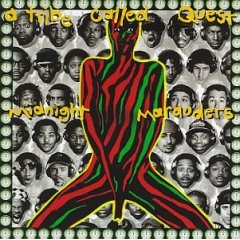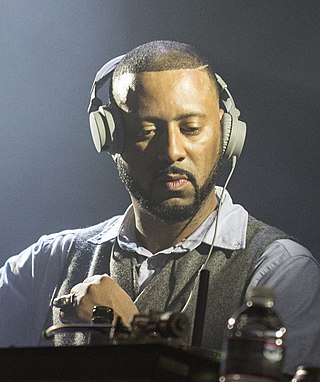Related Research Articles
The new school of hip hop was a movement in hip hop music, beginning in 1983–84 with the early records of Run–D.M.C., Whodini, and LL Cool J. Predominantly from Queens and Brooklyn, it was characterized by drum machine-led minimalism, often tinged with elements of rock; rapped taunts, boasts, and socio-political commentary; and aggressive, self-assertive delivery. In song and image, its artists projected a tough, cool, street b-boy attitude. These elements contrasted sharply with funk and disco, novelty hits, live bands, synthesizers, and party rhymes of artists prevalent in the early 1980s. Compared to their older hip hop counterparts, new school artists crafted more cohesive LPs and shorter songs more amenable to airplay. By 1986, their releases began to establish hip hop in the mainstream.

Keith Edward Elam, better known by his stage name Guru, was an American rapper, record producer and actor. He was a member of the hip hop duo Gang Starr, along with DJ Premier. He was born in Boston, Massachusetts.

Jazzmatazz, Volume 1: An Experimental Fusion of Hip-Hop and Jazz, is the debut solo studio album by American hip hop recording artist Guru. It was released on May 18, 1993, by Chrysalis Records. Recording sessions took place at D&D Studios in New York. Production was handled by Guru himself, who also served as executive producer together with Duff Marlowe and Patrick Moxey.

Acid jazz is a music genre that combines elements of funk, soul, and hip hop, as well as jazz and disco. Acid jazz originated in clubs in London during the 1980s with the rare groove movement and spread to the United States, Western Europe, Latin America and Japan. Acts included The Brand New Heavies, Incognito, James Taylor Quartet, Us3, and Jamiroquai from the UK, and Guru, Buckshot LeFonque and Digable Planets from the U.S. The rise of electronic club music in the middle to late 1990s led to a decline in interest, and in the twenty-first century, acid jazz became indistinct as a genre. Many acts that might have been defined as acid jazz are seen as jazz-funk, or nu jazz.

Midnight Marauders is the third studio album by American hip hop group A Tribe Called Quest, released on November 9, 1993, by Jive Records. Recording sessions for the album occurred at Battery Studios, Platinum Island Studios and Scorcerer Sound in New York City. Its production was mainly handled by Q-Tip, with contributions from Skeff Anselm, Large Professor and the group's DJ, Ali Shaheed Muhammad. A culmination of the group's two previous albums, People's Instinctive Travels and the Paths of Rhythm and The Low End Theory, it features an eclectic, gritty sound based on jazz, funk, soul and R&B samples, in addition to socially conscious, positively-minded, and humorous lyrics.

Christopher Edward Martin, known professionally as DJ Premier, is an American DJ and record producer. He is considered one of the greatest hip hop producers of all time. He was half of the hip hop duo Gang Starr—alongside the rapper Guru—and presently forms half of the hip hop duo PRhyme, together with Royce da 5'9".

Kamaal Ibn John Fareed, better known by his stage name Q-Tip, is an American rapper, record producer, singer, and DJ. Nicknamed the Abstract, he is noted for his innovative jazz-influenced style of hip hop production and his philosophical, esoteric and introspective lyrical themes. He embarked on his music career in the late 1980s, as an MC and main producer of the influential alternative hip hop group A Tribe Called Quest. In the mid-1990s, he co-founded the production team The Ummah, followed by the release of his gold-certified solo debut Amplified in 1999. In the following decade, he released the Grammy Award-nominated album The Renaissance (2008) and the experimental album Kamaal the Abstract (2009).
Rare groove is music that is very hard to source or relatively obscure. Rare groove is primarily associated with funk, R&B and jazz funk, but is also connected to subgenres including jazz rock, reggae, Latin jazz, soul, rock music, northern soul, and disco. Vinyl records that fall into this category generally have high re-sale prices. Rare groove records have been sought by not only collectors and lovers of this type of music, but also by hip hop artists and producers.

Peter O. Phillips, better known by his stage name Pete Rock, is an American music producer, DJ and rapper. He is widely recognized as one of the greatest hip hop producers of all time, and is often mentioned alongside DJ Premier, RZA, and Q-Tip as one of the mainstays of 1990s East Coast hip hop production. He rose to prominence in the early 1990s as one half of the critically acclaimed group Pete Rock & CL Smooth. Early on in his career, he was also famed for his remix work.

Otis Jackson Jr., known professionally as Madlib, is an American DJ, music producer, multi-instrumentalist, and rapper. He is widely known for his collaborations with MF DOOM, J Dilla, and Freddie Gibbs. Madlib has described himself as a "DJ first, producer second, and MC last." His stage name is an acronym for "Mind Altering Demented Lessons In Beats".

Whodini is an American hip hop group that was formed in 1982. The Brooklyn, New York–based trio consisted of vocalist and main lyricist Jalil Hutchins; co-vocalist John Fletcher, a.k.a. Ecstasy ; and turntable artist DJ Drew Carter, a.k.a. Grandmaster Dee.
Jazzmatazz is a series of hip hop and jazz recordings from American rapper Guru.

Hip hop production is the creation of hip hop music in a recording studio. While the term encompasses all aspects of hip hop music creation, including recording the rapping of an MC, a turntablist or DJ providing a beat, playing samples and "scratching" using record players and the creation of a rhythmic backing track, using a drum machine or sequencer, it is most commonly used to refer to recording the instrumental, non-lyrical and non-vocal aspects of hip hop.

Golden age hip hop refers to mainstream hip hop music created from the mid or mid-late 1980s to the early or early-mid 1990s, particularly by artists and musicians originating from the New York metropolitan area. A successor to the new-school hip hop movement, it is characterized by its diversity, quality, innovation and influence on overall hip hop after the genre's emergence and establishment in the old-school era, and is associated with the development and eventual mainstream success of hip hop. There were various types of subject matter, while the music was experimental and the sampling from old records was eclectic.

Guru's Jazzmatazz: Streetsoul is the third solo studio album by American hip hop musician Guru. It was released on October 3, 2000, via Virgin Records as the third installment of Guru's Jazzmatazz album series. Production was handled by Gang Starr, The Neptunes, Agallah, DJ Scratch, Erykah Badu, J Dilla, The Roots and Victor Flowers.

Hip Hop Connection (HHC) was the longest running monthly periodical devoted entirely to hip hop culture. It was described by rapper Chuck D as "the most important magazine in the world".
daKAH or daKAH hip hop orchestra is an orchestra co-founded by Los Angeles composer and the orchestra's conductor Geoff Gallegos with a diverse group of 23 musicians in 1999.

Lonnie Liston Smith Jr. is an American jazz, soul, and funk musician who played with such jazz artists as Pharoah Sanders and Miles Davis before forming Lonnie Liston Smith and the Cosmic Echoes, recording a number of albums widely regarded as classics in the fusion, smooth jazz and acid jazz genres.
Hip-hop or hip hop music, also known as rap, and formerly as disco rap, is a genre of popular music that originated in the early 1970s by African Americans and Afro-Caribbean immigrants in the Bronx, a borough of New York City. Hip-hop music originated as an anti-drug and anti-violence genre consisting of stylized rhythmic music that often accompanies rapping, a rhythmic delivery of poetic speech. In the early 1990s, a professor of African American studies at Temple University said, "hip hop is something that blacks can unequivocally claim as their own." By the 21st century, the field of rappers had diversified by both race and gender. The music developed as part of the broader hip hop culture, a subculture defined by four key stylistic elements: MCing/rapping, DJing/scratching with turntables, breakdancing, and graffiti art. While often used to refer solely to rapping and rap music, "hip hop" more properly denotes the practice of the entire subculture. The term hip hop music is sometimes used synonymously with the term rap music, though rapping is not a required component of hip hop music; the genre may also incorporate other elements of the culture, including DJing, turntablism, scratching, beatboxing, and instrumental tracks.
Alternative hip hop is a subgenre of hip hop music that encompasses a wide range of styles that are not typically identified as mainstream. AllMusic defines it as comprising "hip hop groups that refuse to conform to any of the traditional stereotypes of rap, such as gangsta, bass, hardcore, and party rap. Instead, they blur genres drawing equally from funk and pop/rock, as well as jazz, soul, reggae, and even folk."
References
- 1 2 3 "Jazz-Rap Music Genre Overview". AllMusic. Retrieved 4 June 2018.
- ↑ "Gil Scott-Heron, Spoken-Word Musician, Dies at 62". The New York Times. 28 May 2011. Retrieved 16 January 2012.
- ↑ Starks, George L.; Giddins, Gary; Rusch, Robert D.; Gridley, Mark C. (1986). "Rhythm-A-Ning: Jazz Tradition and Innovation in the 80's". The Black Perspective in Music. 14 (2): 187. doi:10.2307/1214987. ISSN 0090-7790. JSTOR 1214987.
- ↑ Williams, Justin A. (2010-10-01). "The Construction of Jazz Rap as High Art in Hip-Hop Music". Journal of Musicology. 27 (4): 435–459. doi:10.1525/jm.2010.27.4.435. hdl: 1983/6b6784b2-5f18-421a-9669-2aedabe9cc2d . ISSN 0277-9269.
- ↑ Eric B & Rakim Don't Sweat the Technique allmusic Retrieved 14 March 2024
- ↑ "The Victoria Advocate - Google News Archive Search". news.google.com.
- ↑ US Hot 100 Billboard Retrieved 14 May 2024
- ↑ "Durst, Albert Lavada", Texas State Historical Association. Retrieved 23 November 2016.
- ↑ Hilmes, M. (1997). Radio Voices: American Broadcasting, 1922-1952. Minneapolis: University of Minnesota Press, p. 272-3.
- ↑ Marsha Washington George (28 March 2002). Black Radio ... Winner Takes All: America's 1St Black Djs. Xlibris Corporation. pp. 90–. ISBN 978-1-4628-1993-5
- ↑ "Exhibition Traces Development of Hip hop". Pittsburgh Post-Gazette at news.google.com. 19 December 2000. p. 26. Retrieved 4 June 2018.
- ↑ "The 10 Best Jazz Rap Albums To Own On Vinyl — Vinyl Me, Please". Vinylmeplease.com. 2016-11-04. Retrieved 2018-09-15.
- ↑ Hunt, Dennis (June 29, 1993). "Liberating Rap With Jazz Sound : Freestyle Fellowship Adds Riffs to Rhymes". Los Angeles Times. Retrieved May 22, 2017.
- ↑ Aldrich, Steve. "Doo-Bop". AllMusic. Retrieved 13 March 2024.
- ↑ Cunningham, Phillip Lamarr (9 September 2010). ""There's Nothing Really New under the Sun": The Fallacy of the Neo-Soul Genre". Journal of Popular Music Studies. 22 (3): 240–258. doi:10.1111/j.1533-1598.2010.01240.x.
- ↑ "Jazzmatazz, Vol. 1 > Overview". allmusic.com. Retrieved April 24, 2010.
- ↑ "Madlib: Shades of Blue". pitchfork.com. Retrieved 2017-01-03.
- ↑ Winnig, Brolin (March 31, 2006). "Kero One Windmills Of The Soul". XLR8R . Retrieved February 1, 2006.
- ↑ Woodman-Nance, Emily (March 19, 2010). "KUCI" . Retrieved March 19, 2010.
- ↑ Weiss, Dan (March 20, 2015). "Review: Kendrick Lamar Returns With the Great American Hip-Hop Album, 'To Pimp a Butterfly'". Spin. Retrieved March 20, 2015.
- ↑ "Kojaque | Plec Picks 2019 • GoldenPlec".